AutoElectric VehiclesLexus RZ 450e first drive: This EV swaps its steering wheel for a yokeThe RZ is a £62,000 electric SUV that shares its platform with the Toyota bZ4XWhen you purchase through links on our site, we may earn an affiliate commission.Here’s how it works.
AutoElectric VehiclesLexus RZ 450e first drive: This EV swaps its steering wheel for a yokeThe RZ is a £62,000 electric SUV that shares its platform with the Toyota bZ4XWhen you purchase through links on our site, we may earn an affiliate commission.Here’s how it works.
The RZ is a £62,000 electric SUV that shares its platform with the Toyota bZ4X
When you purchase through links on our site, we may earn an affiliate commission.Here’s how it works.
(Image credit: Future / Alistair Charlton)

(Image credit: Future / Alistair Charlton)
The RZ is a big deal for Lexus because, while almost all of the cars itsells in Europe are electrified to some degree, this is the first to be sold as a pure-EV. It cannot be bought with an engine or as a hybrid.
The RZ is closely related to the Toyota bZ4X, with both cars sharing the same 400-volt electrical architecture and 71.4 kWh battery (64 kWh usable capacity). But, as has always been the case, Lexus is positioning its car at the higher end of the market. As such, the RZ is priced from £62,600, compared to £45,710 for the Toyota.
Their dimensions and exterior design are also similar, but with the RZ gaining the familiar Lexus face and a distinctive rear end, complete with a pair of fins stretching rearwards from the roof and a high, full-width light bar. It’s a handsome car that looks futuristic but manages not to shout too loudly about being being electric.
Although not going into production until 2025, One Motion Grip was available to try at the recent press drive of the RZ. More on that later.
For now, we’ll tackle the RZ with a regular steering wheel, just as it will be delivered to customers starting this summer.
Sign up to the T3 newsletter for smarter living straight to your inbox
Get all the latest news, reviews, deals and buying guides on gorgeous tech, home and active products from the T3 experts
Drivetrain and performance
(Image credit: Future)
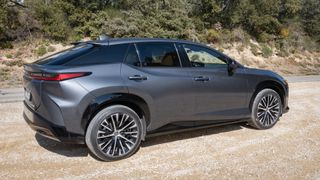
(Image credit: Future)
Unlike its Toyota sibling, the Lexus is only offered in a dual-motor configuration, with a system called Direct4 used to switch between front, rear and all-wheel-drive in mere milliseconds, depending on how the car is being driven and what the road surface is like. Lexus says this technology is far quicker at reacting than a mechanical equivalent, and it uses speed, steering input and even G-force to work out how much power should go where.
There’s plenty going on beneath the surface, but in reality it’s impossible to tell which motor is doing what. For a car like this, where the nuances of front vs rear vs all-wheel-drive are entirely irrelevant, ignorance is bliss. Whatisworth focusing on is how quickly the Lexus launches itself down the road. As is increasingly the case with today’s powerful electric cars, the RZ is far quicker than it has any right to be, sprinting to 62 mph in 5.6 seconds on a wave of torque. Total power output is 313 hp – almost 100 more than the Toyota – with the front motor responsible for up to two-thirds of that.
Cabin, connectivity… and knee warmers
(Image credit: Lexus)
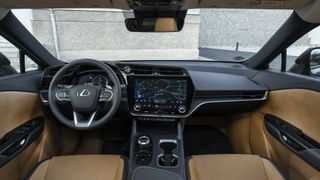
(Image credit: Lexus)
It’s a good looking interior with plenty of tactile switchgear that is easy to use, including rotary dials for the cabin temperature and gear selector. No fewer than three USB-C ports sit below the climate controls and there’s a wireless phone charger too, so all your devices can be topped up at once.
The rest of the cabin has the quality you’d expect from a Lexus, with highlights including a panoramic glass roof that can be dimmed with the press of a button, patterned ambient lighting projected onto the door cards and what Lexus calls “radiant heaters” that blow warm air at your knees from below the dashboard. Sounds strange, but it’s actually rather pleasant and, Lexus says, a more energy-efficient way of warming the RZ’s occupants.
Range, charging and efficiency
(Image credit: Future)
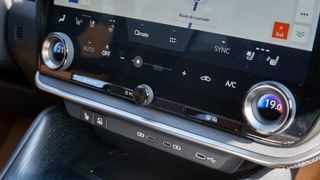
(Image credit: Future)
Lexus says the RZ should achieve between 3.3 and 3.7 miles per kWh (between 16.8 and 18.7 km kWh per 100km, using the European measurement for EV efficiency), and it’ll charge at up to 150 kW, with a charge to 80 percent taking as little as 15 minutes. We managed to better that efficiency target, hitting an impressive 4.0 miles per kWh during about 75 minutes of driving, albeit not at motorway speed.
The steering and braking are both perfectly adequate for a car of this type, and the amount of regenerative braking can be adjusted as you drive using paddles behind the steering wheel. I would personally prefer the option for more aggressive regen, but I suspect many RZ buyers will be acquiring their first electric car, so Lexus has dialled in a milder, more natural regen.
One Motion Grip: Has Lexus reinvented the wheel?
(Image credit: Future)
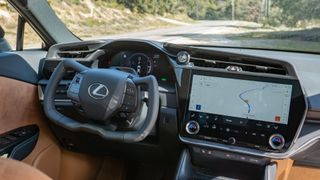
(Image credit: Future)
The result is a yoke that only rotates 150 degrees, but which turns the wheels more quickly at low speed and slower at higher speed. This means parking manoeuvres can be completed without hand-over-hand steering, hence the yoke shape encouraging the driver to keep their hands in the same quarter-to-three position at all times.
Does it work?
(Image credit: Lexus)
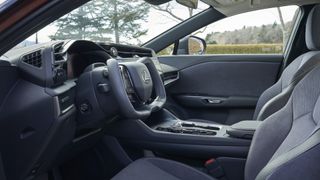
(Image credit: Lexus)
Had you been there, dear reader, you would be forgiven for thinking I was a learner on their first driving lesson. As I pointed the RZ out of the hotel car park and onto a quiet side road, my inputs were sharp and jerky, like those of a teenager unaware of how much steering input is needed to navigate a junction.
During these first few moments, the One Motion Grip took all of the muscle memory I had acquired in 15 years of driving, reset it back to zero and forced me to relearn the basics of car control. My first turn across a junction came with a side-order of panic, as my brain fought against what my eyes, hands and inner-ear were telling it. Convincing your grey matter that you’ve applied enough steering lock to miss a wall, a barrier or a parked car takes real effort, as the car turns more tightly than the amount of steering lock would suggest.
The yoke design also comes with a shorter indicator stalk and smaller paddles for adjusting the regenerative braking. They are all more difficult to use as a result.
I spent about 45 minutes driving with the One Motion Grip, then the same time as a passenger. During this hour-and-a-half my passenger and I talked about nothing else. Initial panic gave way to amusement and eventually confidence, once we had learned to trust the system and recalibrated our minds to sing from the same hymn sheet.
What are the benefits?
(Image credit: Future)
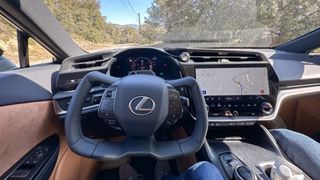
(Image credit: Future)
Lexus says the benefits of a variable steering ratio mean an enhanced connection between car and driver, hands that are always on the wheel (sorry, yoke), and less feedback from the tyres and brakes, as there’s no physical connection. A better view of the instrument cluster is also possible, and to this end the RZ’s binnacle is higher and further away than normal.
But, for now at least, I don’t feel the same way. Asking drivers to re-learn something as fundamental as steering, in pursuit of such small gains, feels unnecessary. Drivers may rightly complain about steering wheels covered in frustrating touch pads instead of physical buttons (the RX actually scores well here, with lots of tactility), but when did you last hear anyone complain about having to steer hand-over-hand?
I may be proved wrong between now and 2025 when Lexus plans to put the One Motion Control into production, but for now it feels like a solution to a problem that doesn’t exist. It will certainly make the RZ stand out from an increasingly crowded market of similar electric SUVs, but in such a car the technology feels incongruous.
Using the yoke feels like playing a computer game. There’s nothing wrong with that in isolation, but it doesn’t sit right in a car that also tries to woo customers who, to quote Lexus on the RZ’s heating system, want the feeling of “having a warm blanket wrapped around their legs.”
Lexus RZ first-drive verdict
It feels unfair to include the One Motion Grip in my conclusion, because it isn’t finished yet, won’t be available until 2025 and a lot may change between now and then.
As it stands today, with a normal wheel, the RZ is a smartly designed EV with sharp styling, a very smooth and comfortable ride (on the test route, at least), a refined cabin with a novel take on passenger heating, and better-than-expected efficiency. It’s a fair bit more expensive than the Toyota on which it is based, but the RZ comes from a premium brand and I can see plenty of existing Lexus owners using this as an opportunity to buy their first electric car.
Tactile buttons on the steering wheel are welcome in a world increasingly moving to haptic touch controls, and while I’m not fully sold on the bulkiness of the touchscreen, the infotainment system works pretty well and I’m a fan of the ambient lighting.
The RZ isn’t a game-changing EV, but it’s a well-executed first effort from Lexus that offers a slightly left-field alternative to cars from Audi, BMW and Jaguar.

Vollebak pushes the limits of outerwear with Double Graphene Puffer and Shielding SuitThe company continues to weave innovation into every thread
The company continues to weave innovation into every thread

Bowers & Wilkins Pi6 review: sensational sound, ordinary ANCBowers & Wilkins' step-down true wireless earbuds sound amazing and are well-priced – so what’s the catch, if anything?
Bowers & Wilkins' step-down true wireless earbuds sound amazing and are well-priced – so what’s the catch, if anything?